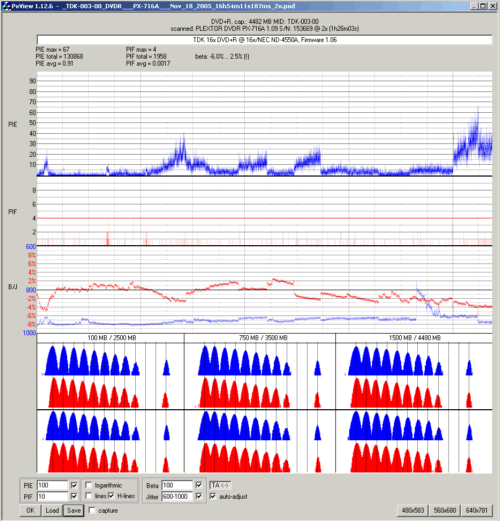| supported drives | PX-716, PX-714, PX-712, Premium and probably PX-708A2 |
| supported tests |
|
|
| Maximum scanning speed for C1/C2/CU and PIE/PIF (drive limitations) |
| Drive | CD-R | CD-RW | DVD±R(W) | DVD±R DL |
| Premium | 24x | 24x | n/a | n/a |
| PX-712 | 48x | 40x | 12x | 12x |
| PX-714/716 | 48x | 40x | 12x | 8x |
|
|
| scale | adjustable (automatically as well as manually), linear and logarithmic scale |
| window size | freely adjustable + predefineable sizes |
| pxd file output | Those files contain all error values. That means,
you can easily make new picture files from old scan results without having
to rescan anything |
| typical window size of output picture file | less than 450x1000 pixels
(for a doublelayer dvd+r disc including PIE, PIF, J/B and TA test results),
compared to more than 4 times that much for PlexTools screenshots |
| typical output PNG file size | 8..40 kB (PIE data only..doublelayer disc with all tests) |
| storing meta data | The output pxd file contains not only error
data, but also some information about the disc itself (manufacturer ID, disc type, number of layers, position of layer break, for dvd-r the dvd writer
used to record the disc) |
| pie | perform pisum8 test |
| pisum8 | perform pisum8 test |
| pif | perform pif test |
| jitterbeta | perform jitter and beta test (only on DVDs) |
| ta | perform TA test. You can manually indicate the positions to run
the TA test at for single layer discs and for Layer 0 of double layer discs, like
ta=100MB,3000MB,4480MB.
Note that you can theoretically test the Leadout area, or
even unrecorded area, however, values above 4600MB will not be accepted. You can
indicate only 6 positions due to limitations of PxView |
| cx | perform C1/C2 test (only on CDs) |
| all | perform all available tests (out of cx, pisum8, pif, jitter/beta, ta test). This
is equal to cx pie pif jitterbeta ta |
| drivenbr=i | use the ith drive for scanning. A large value for i will list all drives available |
| serial=s | Use drive for scanning of which the serial number contains the string s |
| debug | produce excessive debug output |
| destfile=name | defines the output file name (can include %-placeholders). Use "destfile="
to have PxScan automatically create a (hopefully) unique file name. |
| autolaunch | Launch PxView immediately after scanning has been finished and have PxView automatically
create a PNG file |
| abort=n | Abort PIE and PIF scan after n read errors |
| multi | Ask for next disc once scanning is done |
| issue | reason |
| The Plextor PX-712 cannot tell a DVD±R DL apart from a DVD-ROM | This is a firmware limitation only Plextor could fix |
| POFs (i.e. read errors) cannot be detected with PxScan. | I don't know how to do that while a quality check is in progress. However, you can easily check for those by doing a Nero DVD Speed transfer rate test. POFs will be reported as "uncorrectable L-EC error". Other error messages usually mean that the drive has not found anything to perform any error correction on, which is even worse than a POF. |
| PxView can display images on 16 and 32bit desktops (16 bit beginning with version 1.4) only. Saving pictures only works on 32 bit desktops. This is actually a bug, but no new version of PxView will be released just to fix this. Please use a 32 bit desktop. |
I'm lazy :P |
| PxScan v1.7.12 | 2007/02/24 | 94 kB | Fixes a bug due to which TA-scanning on PX-760 for DVD-R/W saved bad pxd files |
| PxScan v1.7.11 | 2007/02/04 | 94 kB | Handles file names with drive and directories better and improves detection of locked drives. |
| PxView 1.12.6 | 2006/06/24 | 45 kB | Support for new TA meta information stored by PxScan 1.7.10. Note: I got a report that the version from June 21st didn't launch on some systems because of missing files such as MFC71.DLL. The reason is that PxView is dynamically linked to MFC and that I've compiled that version with Visual Studio 2003 instead of Visual Studio 6. This new build was compiled with the same source code (thus I didn't change the version number), but with Visual Studio 6, so that those missing files are not needed. |
| PxView 1.12.5 | 2006/05/14 | 45 kB | - fixed problem that corrupt filename was shown when launching pxview from command line with a file to open without full path, for example by using pxscan's autolaunch parameter
- fixed problem that loading a file from command line with 0 C2 errors lead to bad position of jitter/beta label
|
| libgfl.rar | 2006/04/01 | 375 kB | Needed by PxView in order to support PNG file output. Note that the link where I downloaded this is dead, I have no idea where the official page is or if there is any. Google didn't help me last time I tried |
| source code | 2006/06/21 | 90 kB | licence: GPL for PxScan and PxView, except for the parts taken from the gflSDK. Please following the link to the gflSDK to find further information about its licence |
